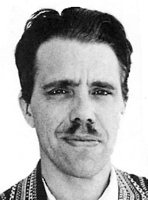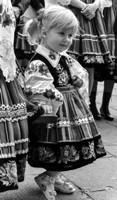
|
The Society of Folk Dance Historians (SFDH)
Where Have All the Children Gone?
[
Home |
About |
Encyclopedia | CLICK AN IMAGE TO ENLARGE |

|
For some time now, it has been increasingly evident that the age of median of both California folk dance Federations has been getting older. None have been more aware of it than their leadership. Accusations that the "old guard" wants to hang on and exclude the younger dancers is really unfair, though there have certainly been some new cases, and many attempts to interest youth to participate actively in running the Federations have come to naught. In the current issue of Let's Dance! magazine, in the long-range survey conducted by the northern Federation under the section "Publicity-Membership," an even half of the replies published stress the need for the infusion of young blood in the folk dance movement, particularly that of the Federation.
So, where have all the children gone? It was not always this way. As a matter of fact, the prime movers in the formation here in the Southland were the young people of college and university groups who got the thing off the ground. With the help and advice, of course, from some of the older leaders, especially among the folk dance teachers and square dance callers, plus three or four ethnic groups composed of teen-age or a bit older dancers.
The general, the cry one hears now is more or less to the effect that, "We need the children and young folk. Without them, we cannot continue. Without the young, there'll be no old!" Of course, to that some cynic will point out that without older folk, you won't have any children, either! I guess we really need each other.
 But where HAVE all the children gone? Have they all really done so? Maybe it is not all that serious. At least, not 100 percent serious. We have several young people in the Federation today who are very active, youngsters who have "come up through the ranks" as it were, who came to the dances and were parked in their playpens fifteen to twenty years ago, and developed and maintained an interest in folk dance, some even after their parents began to cool off. There are some who are a bit further on than "young people," into their 30s, who followed the same pattern. I can name a score here in the Southland who followed that route and have become excellent teachers and leaders, at least three who have become tops in their fields and are known well beyond the borders of California. Others are, I am sure, well on the road to staying with it. There were half a dozen children of folk dancers, by that I mean those in the teen-age brackets, at the Idyllwild Folk Dance Workshop and San Diego State University Folk Dance Conference [both camps now defunct, ed.] folk dance camps, some of whom are already trying out their hands (and feet) at teaching. It seems that those who become interested enough to teach or help teach, are those who remain with the movement.
But where HAVE all the children gone? Have they all really done so? Maybe it is not all that serious. At least, not 100 percent serious. We have several young people in the Federation today who are very active, youngsters who have "come up through the ranks" as it were, who came to the dances and were parked in their playpens fifteen to twenty years ago, and developed and maintained an interest in folk dance, some even after their parents began to cool off. There are some who are a bit further on than "young people," into their 30s, who followed the same pattern. I can name a score here in the Southland who followed that route and have become excellent teachers and leaders, at least three who have become tops in their fields and are known well beyond the borders of California. Others are, I am sure, well on the road to staying with it. There were half a dozen children of folk dancers, by that I mean those in the teen-age brackets, at the Idyllwild Folk Dance Workshop and San Diego State University Folk Dance Conference [both camps now defunct, ed.] folk dance camps, some of whom are already trying out their hands (and feet) at teaching. It seems that those who become interested enough to teach or help teach, are those who remain with the movement.
Perhaps therein lies one of the answers. Camp scholarships to those who have the capability and interest to teach or lead. Recognition is a strong motivation. It is natural that those who have been exposed to folk dancing most of their young lives through association with their parents would have a clearer view of it, and if their vibes were positive, they would be fit candidates for teaching and leadership. Perhaps our Federation scholarships should be especially directed to even younger people than we have been doing in the past, and think of them as being investments in the future. The club scholarships would likewise tend to perpetuate their group's existence. Over the years, quite a number of youngsters have had scholarships awarded, and there have been some bummers, too. Since then, however, the awarding committees have been much more discriminating in making selections.
But the young people are not ALL gone really. In fact, there are probably as many of them around as there are older ones (again, it depends upon where you draw the line of demarcation). Look at the coffee houses [all now defunct, ed.], the college groups, some of the Centers – there are many folk dancers of the sixteen to twenty-five bracket, all visibly enjoying folk dancing. So, what does one do to wean them to the Federation and other groups? Ay, there's the rub. That is what perhaps the Federation North may be able to develop after their survey is analysed. While that survey is on the folk dance situation up there in general, the fact that the question of youth activity turned up in so many replies will undoubtedly dwell strong in the analysis.
Way, way out in the open for anyone to observe is one reason the youth are happy with the way things are – the type of dances done. The lively Balkan and euphorious Israeli dances contrast from the more staid couple dances and sets of the older groups. At least, that is one reason often given – yet on the other hand, a possible higher percentage of dances done at the older groups are line dances because of the fact that the imbalance of sexes at the latter require more line dances be programmed. And, too, the young people are beginning to discover that "touch" dances, those where you get to hold someone of the opposite sex sort of close with maybe a pat or squeeze now and then, is a pretty good feeling!
As the editor of Folk Dance Scene, I have probably been in closer contact with both leadership and rank-and-file membership of the collegiate/youth groups than most others of my age and have heard many, many stories and impressions rendered. To some, the Federation is a mysterious something, to others a sort of ogre, and invariably, after my having explained away some misunderstanding to our mutual satisfaction, some one or more of our "old guard" will say something or do some excruciatingly patronizing thing that confirms what they believed about the Federation all along. Then, of course, there are the occasional young "Turks" who believe that a shock therapy is good for what ails us, thereby nullifying my other arguments, too.
No, the children have NOT all gone. The thing to do now is to try to get as many as possible past the era of roller skates and other things and keep them with us – to work with the college-university people on a one-to-one basis, and be willing to share in the operation of our various organizations.
DOCUMENTS
- Attracting and Retaining New Folk Dancers, an article.
- Attracting New Dancers, an article.
- Chronology of International Folk Dancing, an article.
- Folk Dance Decline and Resurrection, an article.
- Folk Dance Demise, an article.
- Folk Dance Revival, an article.
- IFDC Challenges Declining Numbers, an article.
- Let's Bring Folks Back to Recreational Folk Dancing, an article.
- Reviving Folk Dance, an article.
- Revitalization Committee Report, an article.
- Three Kinds of Teachers: Which Shall We Follow?, an article.
- We Need a Commercial!, an article.
Printed in Folk Dance Scene, October 1979.
This page © 2018 by Ron Houston.
Please do not copy any part of this page without including this copyright notice.
Please do not copy small portions out of context.
Please do not copy large portions without permission from Ron Houston.